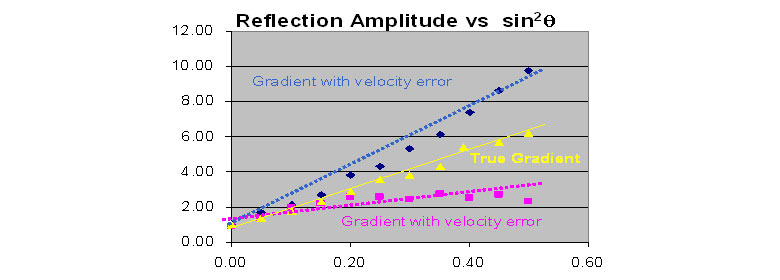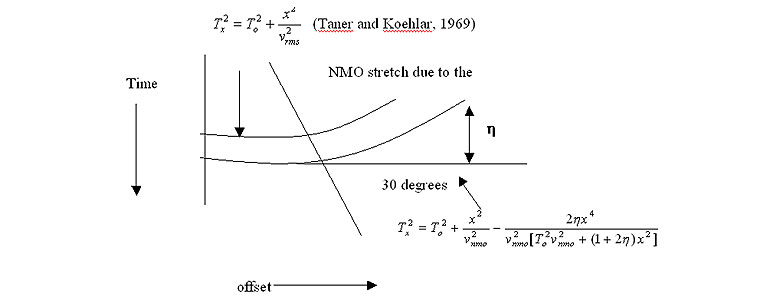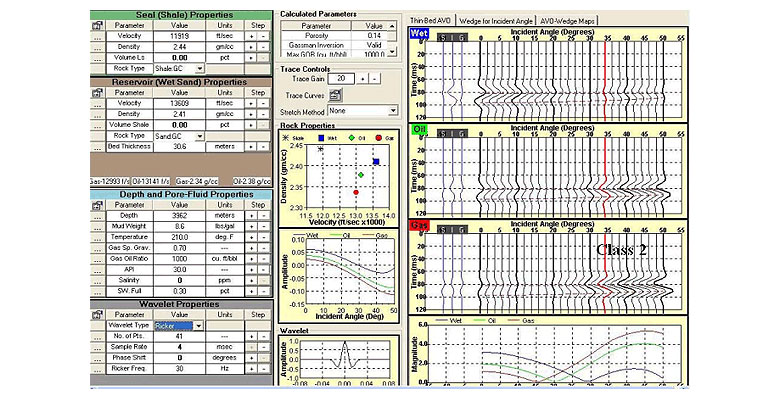Abstract
AVO has played a significant role in exploration over the last 20 years. However, the use of amplitudes as a direct hydrocarbon indicator is still not as reliable as desired. On the other hand experience demonstrates some of the issues needed to be addressed exist within the seismic data itself. Factors within the seismic data affecting the AVO attributes include (Whitcombe et al, 2004):
- Residual velocity;
- Anisotropy;
- NMO stretch (Keho et al, 2001);
- Gain; and
- Overburden effects.

If these factors are not compensated for, then there may be some leakage of the intercept into the gradient (Hermann and Cambois, 2001; Cambois, 2002) and the AVO attributes such as Fluid Factor may be reduced to the far offset stack (Cambois, 2002).

Gather conditioning after prestack migration allows us to correct these issues within the gathers, including residual velocity and anisotropy. (Taner and Koehlar, 1969)

This is where we pick the RMS velocity for stacking of the data and this is also where we have residual NMO. We utilize the BP AVO Workbench AVEL in order to calculate the residual velocity field to flatten this portion of the gather.
 (Two Term NMO equation)
(Two Term NMO equation)
If we are to go beyond 30 degrees of incidence angle then we have issues with the NMO stretch which is caused by the failing of the Two-Term NMO equation which is a hyperbolic equation. The Two-term NMO equation fails because it does not take into account the curve ray effect at the rock boundaries, but it is good for a straight ray approximation. In order to correct the seismic event on the gather beyond 30 degrees we need to utilize a new variable called h which theoretically is a measure of the weak anisotropy within the rock (Thomsen, 1986) and also the curve ray effect combined.
We utilize the  (Alkhalifah and Tsvankin, 1995) equation in order apply the η term to flatten the gather.
(Alkhalifah and Tsvankin, 1995) equation in order apply the η term to flatten the gather.
This 3rd Term Move Out equation yields a flatter output reflector on the CDP gathers because of the curve it uses is no longer hyperbolic but is adjusted to take into account the curve ray effect and the weak anisotropy (Thomsen, 1986). The curve we use better fits the shape of the curve on the gather so when we move out the data we have less NMO stretch on the far offsets.
In addition, industry often fails in tying AVO anomalies into well modeling. Too often there is a large disconnect between geophysics and petrophysics. Geophysicist and petrophysicists complement each other, even though our functions are often kept in separate silos within too many E and P companies. Not integrating the exploration team leaves geophysicists focusing on what can be drawn from the seismic data and the petrophysicists building models which sometimes are eventually be compared to the seismic data (Sneider, 1990). In order to understand AVO in the seismic data we need to do fluid substitutions and look at how it changes the AVO attributes, and we need to build pseudo-rocks from the well data and look at the seismic response.
We emphasize these points with a land seismic case history from Asia, where the rocks are Mesozoic in age. After reviewing the traditional interpretation of the seismic data, we look at the AVO interpretation, tying the AVO interpretation into the well modeling and fluid substitution. We also look at AVO and fluid substitution models created using a new PC product developed by Fred Hilterman called d-TIPS (database Toolkit for Integrating Petrophysics and Seismic). d-TIPS allows us to change parameters and play "what if" games with the well data.

By bringing the seismic data and petrophysical AVO modeling together as soon as possible in the interpretation process, there is a better chance of unraveling true AVO signatures in the data. The interactive nature of d-TIPS allows answers to modeling options to be derived before the question being explored is forgotten.
References
Alkhalifah, T., and Tsvankin, I., 1995, Velocity analysis for transversely isotropic media, Geophysics Vol. 60, 1550-1566.
Cambois, G., 2002, A new approach to the fluid factor leads to elastic inversion without shear log, Soc. Expl. Geophys., Expanded Abtracts.
Herrmann, P., and Cambois, G, 2001, Statistical properties of seismically, derived AVO attributes, Soc. Expl. Geophys., Expanded Abtracts.
Keho, T., Lemanski, S., and Raja, B., 2001, The AVO hodogram: Using polarization to identify anomalies, The Leading Edge, November, p.1214-1224
Sneider, R.M., 1990, The Economic Value of a Synergistic Organization, Proceedings of the 1st Archie Conference, October 22-25, 1990, Houston, TX, "The Integration of Geology, Geophysics, Petrophysics, and Petroleum Engineering in Reservoir Delineation, Description, and Management," p.328-333.
Spratt, S., 1987, Effect of normal move out errors on amplitude versus offset-derived shear reflectivity: 57th Annual International Mtg., Soc. Expl. Geophys., Expanded Abtracts, 634-637.
Swan, H.W., 2001, Velocities from amplitude variations with offset, Geophysics, Vol. 66, 1735-1743
Taner, M.T., and Koehler, F., 1969, Velocity spectra-digital computer derivation and applications of velocity functions, Geophysics, Vol. 34, 859-888.
Biography
Brian Schulte was born and raised in Calgary, Alberta. He attended Mount Royal College and University of Calgary where he majored in Geology with a minor in Geophysics in 1989. His early days with seismic was when he used to visit the land acquisition crews with his father. Lloyd, when he was about 7 years old. He has been involved with seismic processing, land, transition zone and marine acquisition and AVO and has 17 years of experience beginning his career with Gale-Horizon in the Calgary market. He has broad worldwide experience having worked in places like North Slope, Alaska to Tierra del Feugo, Argentina but for the last 8 years he has focused on the Gulf of Mexico.
He has been recently involved in developing processing techniques to illuminate AVO's in seismic data especially Class 2 AVO's for the drilling of deep gas in the Gulf of Mexico where many consider him an expert in the industry in this area and is working for GDC in Houston integrating seismic processing, well modeling and interpretation.
Brian is also involved with the Alief YMCA as a volunteer coach. He enjoys his work with kids seeing them develop in their skills going from individuals with good skill sets to team players who can play well with others and contribute to the team.





